-

- Sopto Home
-

- Special Topic
-

- PCI-E Card Knowledge
-

- Differences between PCI and PCI-X
PCI-E Card Knowledge
- Info about Network Interface Card Teaming
- How to Setup a Server with Multiple Network Interface Adapters?
- How to Reconnect an Internet Network Adapter for an Acer Aspire?
- 9 Things to Do When Your Internal Network Card Stops Working
- Ethernet Standards NIC for Home Networking
- What Is a Network Interface Adapter?
- How to Configure a Network Interface Card in Linux?
- How should Configure Your NIC for ISA and TMG?
- Recommended Network Card Configuration for Forefront UAG Servers
SOPTO Special Topic
Certificate



Guarantee
Except products belongs to Bargain Shop section, all products are warranted by SOPTO only to purchasers for resale or for use in business or original equipment manufacturer, against defects in workmanship or materials under normal use (consumables, normal tear and wear excluded) for one year after date of purchase from SOPTO, unless otherwise stated...
Return Policies
Defective products will be accepted for exchange, at our discretion, within 14 days from receipt. Buyer might be requested to return the defective products to SOPTO for verification or authorized service location, as SOPTO designated, shipping costs prepaid. .....
Applications

PCI-E NIC Cards provide redundant connectivity to ensure an uninterrupted network connection.
PCI-E NIC Cards are ideal for VM environments with multiple operating systems, requiring shared or dedicated NICs.
They are specially designed for desktop PC clients, servers, and workstations with few PCI Express slots available.
SOPTO Products
- Fiber Optic Transceiver Module
- High Speed Cable
- Fiber Optical Cable
- Fiber Optical Patch Cords
- Splitter CWDM DWDM
- PON Solution
- FTTH Box ODF Closure
- PCI-E Network Card
- Network Cables
- Fiber Optical Adapter
- Fiber Optical Attenuator
- Fiber Media Converter
- PDH Multiplexers
- Protocol Converter
- Digital Video Multiplexer
- Fiber Optical Tools
- Compatible
Related Products
Performance Feature
PCI-E Card Knowledge
Recommended


Differences between PCI and PCI-X
PCI (Peripheral Component Interconnect) is a data bus protocol. The first generation of cards that were built to utilize this bus are referred to as PCI cards. Although the term PCI still applies to the data bus in modern computers, several newer generations of interface protocols (such as PCI-X and PCIe) have since been developed. The original protocol for PCI cards and slots are now referred to as ‘Conventional’ PCI cards and slots. Conventional PCI cards are usually 32 bits, but some are 64 bits.
The standard configuration for conventional PCI is 133 MB/s. PCI cards can operate in PCI-X slots of the same operating voltage (3.3V or 5V), even if the PCI-X slot is longer than the PCI card connector.
.jpg)
When a conventional PCI card is running in a PCI-X slot, all other PCI-X slots on the same bus will be limited to the speed of the slowest card.
PCI-X (PCI eXtended) is an enhanced PCI bus technology. All PCI-X cards operate at 64 bits and are capable of up to 1064 MB/s (8 times as much as Conventional PCI peak rates). In many cases, PCI-X is backward compatible with existing PCI cards.
PCI-X cards will operate in PCI slots of the same operating voltage (3.3V or 5V), but the data transfer rate will be limited to the slower PCI rates. If the PCI-X card connector is longer than the PCI slot, mechanical impediments (such as capacitors near the slot) may prevent the card from fitting in the slot.
The following images show the physical differences between different PCI and PCI-X cards and slots:

Differences between different PCI and PCI-X slots

Differences between different PCI and PCI-X cards
Sopto is a professional PCI-E Card manufacturer and provider, our PCIe products mainly include PCIe 1.0 Server Adapters, PCIe 2.0 NIC and PCIe 3.0 Sever Cards and so on.
For more information, please contact a Sopto representative by calling 86-755-36946668, or by sending an email to info@sopto.com.



